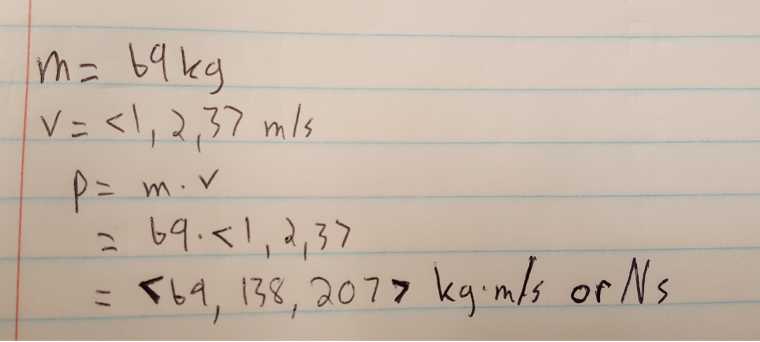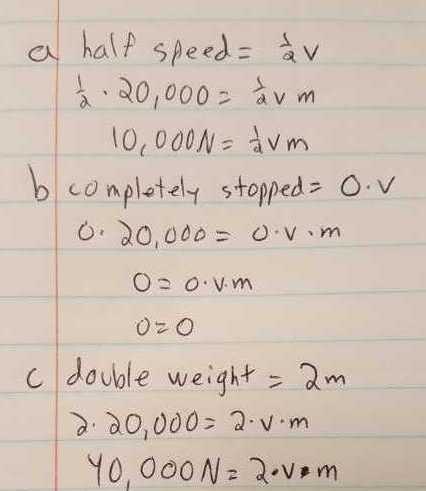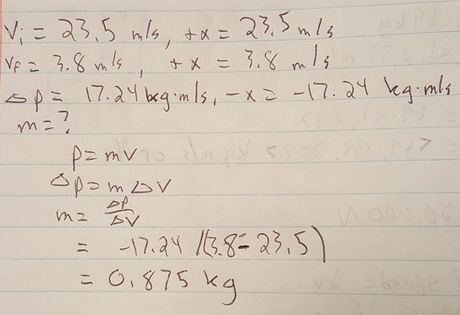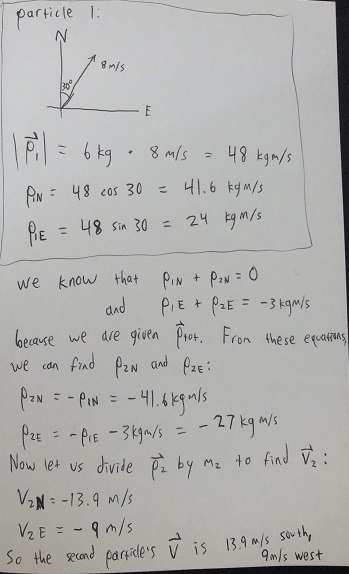Linear Momentum: Difference between revisions
No edit summary |
|||
| (72 intermediate revisions by 2 users not shown) | |||
| Line 1: | Line 1: | ||
This page defines the linear momentum of | This page defines the linear momentum of particles and systems. | ||
==The Main Idea== | ==The Main Idea== | ||
Linear momentum is a vector quantity describing an object's motion. It is defined as the product of an object's | Linear momentum is a vector quantity describing an object's motion. It is defined as the product of an object's [[Mass]] (<math>m</math>) and [[Velocity]] (<math>\vec{v}</math>). Note that mass is a scalar while velocity is a vector, so an object's linear momentum is always in the same direction as its velocity. Linear momentum is a vector quantity. Linear momentum is represented by the letter <math>\vec{p}</math> and is often referred to as simply "momentum." The most commonly used metric unit for momentum is the kilogram*meter/second. The plural of momentum is momenta or momentums. | ||
===A Mathematical Model=== | ===A Mathematical Model=== | ||
====Single Particles==== | ====Single Particles==== | ||
The momentum of a particle is defined as follows: | |||
where p is the | <math>\vec{p} = m\vec{v}</math> | ||
where <math>\vec{p}</math> is the particle's linear momentum, <math>m</math> is the particle's mass, and <math>\vec{v}</math> is the particle's velocity. This formula accurately describes the momentum of particles at everyday speeds, but for particles traveling near the speed of light, the formula for [[Relativistic Momentum]] must be used for concepts such as the momentum principle to remain true. | |||
====Multiple Particles==== | ====Multiple Particles==== | ||
The momentum of a system of particles is the sum of | The total momentum of a system of particles is defined as the vector sum of the momenta of the particles that comprise the system: | ||
<math>\vec{p}_{system} = \sum_i \vec{p}_i</math> | |||
Although the proof does not appear on this page, it can be shown that the total momentum of a system of particles is equal to the total mass of the system times the velocity of its [[Center of Mass]]: | |||
<math>\vec{p}_{system} = M_{tot}\vec{v}_{COM}</math> | |||
This formula makes it significantly easier to calculate the momentum of certain objects. For example, consider a disk rolling along the ground. The disk is comprised of an infinite number of infinitely small "mass elements," all of which have different momenta; the ones at the bottom of the disk are hardly moving while the ones at the top are moving very quickly. Without the formula above, one would have to use an integral to add the momenta of all of the mass elements to find the total momentum of the disk. However, the formula above tells us that we can simply multiply the mass of the disk by the velocity of its center of mass, which is in this case the geometric center of the disk. This reveals that the fact that the disk is rotating does not affect its momentum. | |||
==== | ====Impulse==== | ||
Impulse is the change in momentum. It is the integral of force over a time interval. Therefore, impulse equals to the force, F, multiplied by the change in time, t. The unit for impulse is newton*second. Since impulse is the change in momentum, an alternative formula of impulse is mass, m, multiplied by change in velocity, v. Both the formulae mentioned are important to remember to solve impulse-related questions. | |||
====In Relation to Other Physics Topics==== | |||
When | In the absence of a net force, the momentum of a particle stays constant over time, as stated by Newton's first law. | ||
When a force is applied to a particle, its momentum evolves over time according to Newton's second law. For more information, see [[Newton's Second Law: the Momentum Principle]]. | |||
When an impulse is applied to a particle, its momentum changes in a specific way: the change in momentum <math>\Delta\vec{p}</math> is equal to the impulse <math>\vec{J}</math>. This is a consequence of the Momentum Principle. For more information, see [[Impulse and Momentum]]. | |||
When the net external force on a system of particles is 0, the system's momentum is conserved (that is, constant over time) even if the particles within the system interact with each other (exert internal forces on each other). For more information, see [[Conservation of Momentum]]. | |||
===A Computational Model=== | ===A Computational Model=== | ||
In computational simulations of particles using [[Iterative Prediction]], a momentum vector variable is assigned to each particle. Such simulations usually in "time steps," or iterations of a loop representing a short time interval. In each time step, the particles' momenta are updated based on the forces acting on it. Then their velocities are calculated by dividing each particle's momentum by its mass. Finally, the velocities are used to update the positions of the particles. Below is an example of such a simulation: | |||
This vPython simulation shows a cart (represented by a rectangle) whose motion is affected by a gust of wind applying a constant force. | |||
https://trinket.io/glowscript/ce43925647 | https://trinket.io/glowscript/ce43925647 | ||
For more information, see [[Iterative Prediction]]. | |||
==Examples== | ==Examples== | ||
=== | ===1. (Simple)=== | ||
Find the momentum of a ball that has a mass of 69kg and is moving at <1,2,3> m/s. | Find the momentum of a ball that has a mass of 69kg and is moving at <1,2,3> m/s. | ||
[[File:momentumsimple.jpg]] | [[File:momentumsimple.jpg]] | ||
===Middling=== | ===2. (Middling)=== | ||
A car has 20,000 N of momentum. | A car has 20,000 N of momentum. | ||
How would the momentum of the car change if: | How would the momentum of the car change if: | ||
| Line 59: | Line 62: | ||
b) the car completely stopped? | b) the car completely stopped? | ||
c) the car gained its original weight in luggage? | c) the car gained its original weight in luggage? | ||
[[File:momentummiddling.jpg]] | [[File:momentummiddling.jpg]] | ||
===Difficult=== | ===3. (Difficult)=== | ||
You and your friends are watching NBA highlights at home and want to practice your physics. You notice at the beginning of a clip a basketball ball is rolling down the court at 23.5 m/s to the right. At the end, it is rolling at 3.8 m/s in the same direction. The commentator tells you that the change in its momentum is 17.24 kg m/s to the left. Curious at how many basketballs you can carry, you want to find the mass of the ball. | You and your friends are watching NBA highlights at home and want to practice your physics. You notice at the beginning of a clip a basketball ball is rolling down the court at 23.5 m/s to the right. At the end, it is rolling at 3.8 m/s in the same direction. The commentator tells you that the change in its momentum is 17.24 kg m/s to the left. Curious at how many basketballs you can carry, you want to find the mass of the ball. | ||
[[File:momentumhardaf.jpg]] | [[File:momentumhardaf.jpg]] | ||
== | ===4. (Difficult)=== | ||
A system is comprised of two particles. One particle has a mass of 6kg and is travelling in a direction 30 degrees east of north at a speed of 8m/s. The total momentum of the system is 3kg*m/s west. The second particle has a mass of 3kg. What is the second particle's velocity? Give your answer in terms of a north-south component and an east-west component. | |||
[[File:Momentumadditionalhardsmaller.jpg]] | |||
== | ==Connectedness== | ||
=== | ===Scenario: runaway vehicle=== | ||
Imagine that you are standing at the bottom of a hill when a runaway vehicle comes careening down. If it is a bicycle, it would be much easier to stop than if it were a truck moving at the same speed. One explanation for this is that the truck would have a greater mass and therefore a greater momentum. In order to be brought to rest, the truck must therefore experience a large change in momentum, which means a large impulse must be exerted on it. | |||
==History== | |||
The oldest known attempt at quantifying motion using both an object's speed and mass was that of René Descartes (1596–1650) [https://science.jrank.org/pages/4419/Momentum.html (source)]. John Wallis (1616 – 1703) was the first to use the phrase momentum, and to define it as the product of mass and velocity (rather than speed). He recognized that this notion of momentum is conserved in closed systems [https://www.famousscientists.org/john-wallis/ (source)], a concept confirmed by experiments performed by Christian Huygens (1629-1695) [https://www2.stetson.edu/~efriedma/periodictable/html/Hg.html (source)]. Finally, Isaac Newton (1643-1727) wrote his famous three laws relating momentum to force in his book Principia Mathematica in 1687. These offered a theoretical explanation for conservation of momentum. These foundations were so logically sound and experimentally observable that they would go unquestioned for centuries, until Albert Einstein (1879-1955) had to adjust the formula for momentum to maintain its accuracy for objects moving at relativistic speeds (see [[relativistic momentum]]). | |||
== See also == | == See also == | ||
* | *[[Mass]] | ||
* | *[[Velocity]] | ||
* | *[[Vectors]] | ||
* | *[[Newton's Second Law: the Momentum Principle]] | ||
*[[Impulse and Momentum]] | |||
*[[Conservation of Momentum]] | |||
===Further reading=== | ===Further reading=== | ||
Chabay, Sherwood. (2015). Matter and Interactions (4th ed., Vol. 1). Raleigh, North Carolina: Wiley. | Chabay, Sherwood. (2015). Matter and Interactions (4th ed., Vol. 1). Raleigh, North Carolina: Wiley. | ||
===External links=== | |||
<ol> | |||
<li>https://www.khanacademy.org/science/physics/linear-momentum/momentum-tutorial/v/introduction-to-momentum</li> | |||
</ol> | |||
==References== | ==References== | ||
[[Category: | [[Category: Momentum]] | ||
*http://hyperphysics.phy-astr.gsu.edu/hbase/mom.html | *http://hyperphysics.phy-astr.gsu.edu/hbase/mom.html | ||
*http://study.com/academy/lesson/linear-momentum-definition-equation-and-examples.html | *http://study.com/academy/lesson/linear-momentum-definition-equation-and-examples.html | ||
*https://science.jrank.org/pages/4419/Momentum.html | |||
*https://www.famousscientists.org/john-wallis/ | |||
*https://www2.stetson.edu/~efriedma/periodictable/html/Hg.html | |||
Latest revision as of 09:58, 16 April 2023
This page defines the linear momentum of particles and systems.
The Main Idea
Linear momentum is a vector quantity describing an object's motion. It is defined as the product of an object's Mass ([math]\displaystyle{ m }[/math]) and Velocity ([math]\displaystyle{ \vec{v} }[/math]). Note that mass is a scalar while velocity is a vector, so an object's linear momentum is always in the same direction as its velocity. Linear momentum is a vector quantity. Linear momentum is represented by the letter [math]\displaystyle{ \vec{p} }[/math] and is often referred to as simply "momentum." The most commonly used metric unit for momentum is the kilogram*meter/second. The plural of momentum is momenta or momentums.
A Mathematical Model
Single Particles
The momentum of a particle is defined as follows:
[math]\displaystyle{ \vec{p} = m\vec{v} }[/math]
where [math]\displaystyle{ \vec{p} }[/math] is the particle's linear momentum, [math]\displaystyle{ m }[/math] is the particle's mass, and [math]\displaystyle{ \vec{v} }[/math] is the particle's velocity. This formula accurately describes the momentum of particles at everyday speeds, but for particles traveling near the speed of light, the formula for Relativistic Momentum must be used for concepts such as the momentum principle to remain true.
Multiple Particles
The total momentum of a system of particles is defined as the vector sum of the momenta of the particles that comprise the system:
[math]\displaystyle{ \vec{p}_{system} = \sum_i \vec{p}_i }[/math]
Although the proof does not appear on this page, it can be shown that the total momentum of a system of particles is equal to the total mass of the system times the velocity of its Center of Mass:
[math]\displaystyle{ \vec{p}_{system} = M_{tot}\vec{v}_{COM} }[/math]
This formula makes it significantly easier to calculate the momentum of certain objects. For example, consider a disk rolling along the ground. The disk is comprised of an infinite number of infinitely small "mass elements," all of which have different momenta; the ones at the bottom of the disk are hardly moving while the ones at the top are moving very quickly. Without the formula above, one would have to use an integral to add the momenta of all of the mass elements to find the total momentum of the disk. However, the formula above tells us that we can simply multiply the mass of the disk by the velocity of its center of mass, which is in this case the geometric center of the disk. This reveals that the fact that the disk is rotating does not affect its momentum.
Impulse
Impulse is the change in momentum. It is the integral of force over a time interval. Therefore, impulse equals to the force, F, multiplied by the change in time, t. The unit for impulse is newton*second. Since impulse is the change in momentum, an alternative formula of impulse is mass, m, multiplied by change in velocity, v. Both the formulae mentioned are important to remember to solve impulse-related questions.
In Relation to Other Physics Topics
In the absence of a net force, the momentum of a particle stays constant over time, as stated by Newton's first law.
When a force is applied to a particle, its momentum evolves over time according to Newton's second law. For more information, see Newton's Second Law: the Momentum Principle.
When an impulse is applied to a particle, its momentum changes in a specific way: the change in momentum [math]\displaystyle{ \Delta\vec{p} }[/math] is equal to the impulse [math]\displaystyle{ \vec{J} }[/math]. This is a consequence of the Momentum Principle. For more information, see Impulse and Momentum.
When the net external force on a system of particles is 0, the system's momentum is conserved (that is, constant over time) even if the particles within the system interact with each other (exert internal forces on each other). For more information, see Conservation of Momentum.
A Computational Model
In computational simulations of particles using Iterative Prediction, a momentum vector variable is assigned to each particle. Such simulations usually in "time steps," or iterations of a loop representing a short time interval. In each time step, the particles' momenta are updated based on the forces acting on it. Then their velocities are calculated by dividing each particle's momentum by its mass. Finally, the velocities are used to update the positions of the particles. Below is an example of such a simulation:
This vPython simulation shows a cart (represented by a rectangle) whose motion is affected by a gust of wind applying a constant force.
https://trinket.io/glowscript/ce43925647
For more information, see Iterative Prediction.
Examples
1. (Simple)
Find the momentum of a ball that has a mass of 69kg and is moving at <1,2,3> m/s.
2. (Middling)
A car has 20,000 N of momentum. How would the momentum of the car change if: a) the car slowed to half of its speed? b) the car completely stopped? c) the car gained its original weight in luggage?
3. (Difficult)
You and your friends are watching NBA highlights at home and want to practice your physics. You notice at the beginning of a clip a basketball ball is rolling down the court at 23.5 m/s to the right. At the end, it is rolling at 3.8 m/s in the same direction. The commentator tells you that the change in its momentum is 17.24 kg m/s to the left. Curious at how many basketballs you can carry, you want to find the mass of the ball.
4. (Difficult)
A system is comprised of two particles. One particle has a mass of 6kg and is travelling in a direction 30 degrees east of north at a speed of 8m/s. The total momentum of the system is 3kg*m/s west. The second particle has a mass of 3kg. What is the second particle's velocity? Give your answer in terms of a north-south component and an east-west component.
Connectedness
Scenario: runaway vehicle
Imagine that you are standing at the bottom of a hill when a runaway vehicle comes careening down. If it is a bicycle, it would be much easier to stop than if it were a truck moving at the same speed. One explanation for this is that the truck would have a greater mass and therefore a greater momentum. In order to be brought to rest, the truck must therefore experience a large change in momentum, which means a large impulse must be exerted on it.
History
The oldest known attempt at quantifying motion using both an object's speed and mass was that of René Descartes (1596–1650) (source). John Wallis (1616 – 1703) was the first to use the phrase momentum, and to define it as the product of mass and velocity (rather than speed). He recognized that this notion of momentum is conserved in closed systems (source), a concept confirmed by experiments performed by Christian Huygens (1629-1695) (source). Finally, Isaac Newton (1643-1727) wrote his famous three laws relating momentum to force in his book Principia Mathematica in 1687. These offered a theoretical explanation for conservation of momentum. These foundations were so logically sound and experimentally observable that they would go unquestioned for centuries, until Albert Einstein (1879-1955) had to adjust the formula for momentum to maintain its accuracy for objects moving at relativistic speeds (see relativistic momentum).
See also
- Mass
- Velocity
- Vectors
- Newton's Second Law: the Momentum Principle
- Impulse and Momentum
- Conservation of Momentum
Further reading
Chabay, Sherwood. (2015). Matter and Interactions (4th ed., Vol. 1). Raleigh, North Carolina: Wiley.



